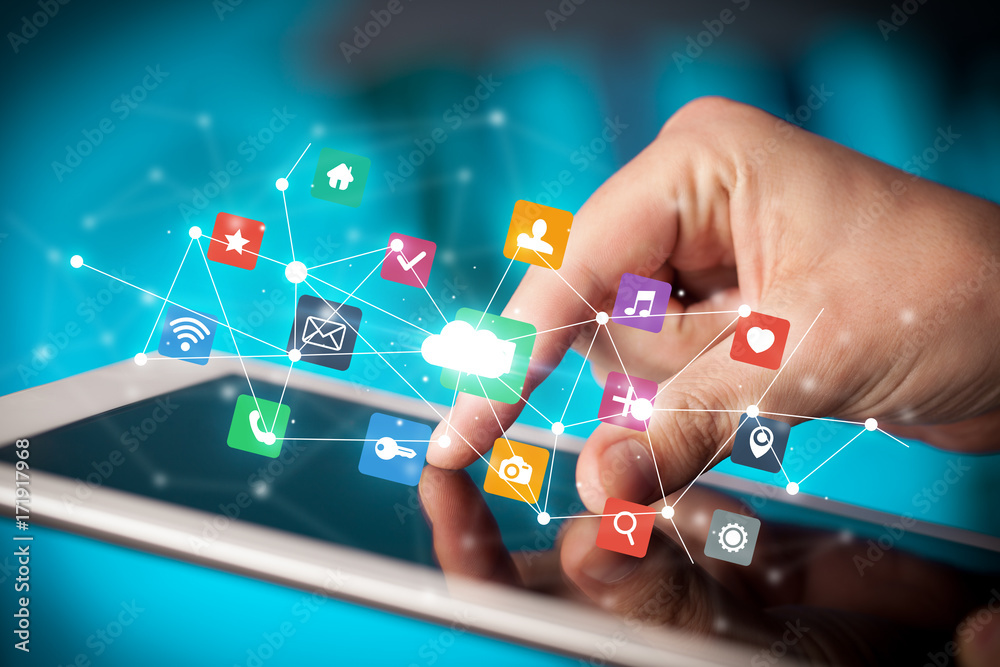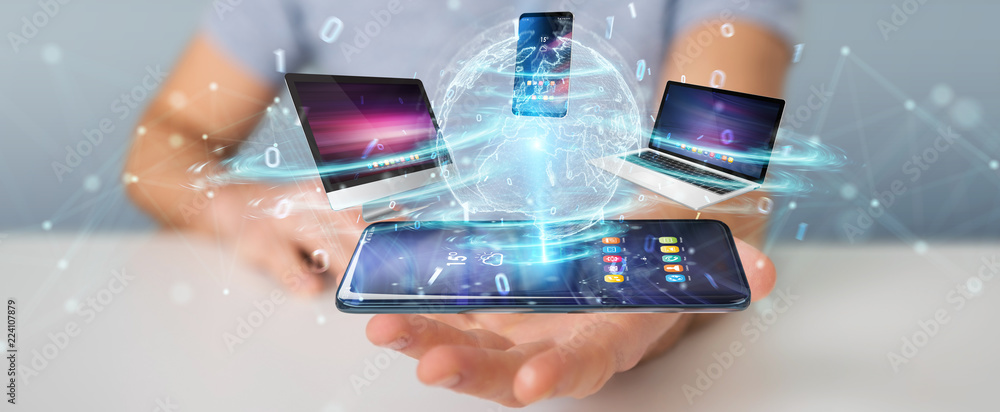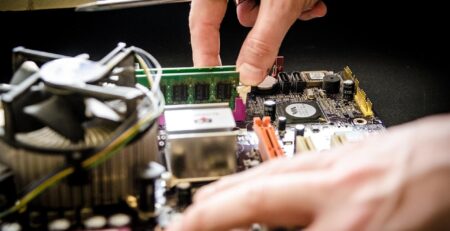The Evolution Of Mobile Phone Technology: From Brick Phones to Foldable Screens
The evolution of mobile phone technology is a remarkable journey that has transformed the way we communicate, access information, and interact with the world around us. From the early days of clunky “brick” phones to the sleek and innovative foldable screens of today, this technological progression has not only changed the form factor of our devices but has also revolutionized entire industries and shaped modern society. From the bulky brick phones of the past to the sleek and versatile foldable screens of today, each phase has brought us closer to a world of unprecedented connectivity and possibilities.
As we reflect on this journey, it becomes evident that mobile phones are not just devices; they are transformative tools that have shaped how we communicate, work, and play, forever altering the fabric of modern life. The only certainty moving forward is that the evolution is far from over, and we can eagerly anticipate the next wave of technological marvels that will continue to reshape our mobile experience. This article explores the captivating timeline of mobile phone evolution, highlighting key milestones and advancements that have led us from the humble beginnings of portable telephony to the cutting-edge era of foldable screens.
Historical Overview
Emergence of the first mobile phones, often referred to as “brick phones.”
The emergence of the first mobile phones, commonly referred to as “brick phones,” marked a transformative moment in the history of telecommunications. These early mobile devices, though rudimentary by today’s standards, laid the foundation for the modern smartphone revolution. The term “brick phone” is a nod to the substantial size and weight of these devices, often resembling a small brick in both appearance and heft.
The first mobile phones, exemplified by the Motorola DynaTAC 8000X, which debuted in 1983, were indeed sizable. These devices were predominantly used for voice communication and boasted little more than the essential functions of making and receiving calls. The design prioritized functionality over aesthetics, resulting in devices that were bulkier and heavier than most contemporary electronic gadgets.
Despite their unwieldy nature, brick phones quickly found favor among certain demographics, most notably business professionals. The ability to communicate while on the move was a game-changer for individuals who relied heavily on frequent interactions and needed to stay connected beyond the confines of their office or home. Business executives, salespeople, and professionals who were often on the road or away from a landline phone became the early adopters of these mobile devices.
Technological limitations of these early devices, including battery life and network coverage
While the advent of brick phones was revolutionary, these early devices were fraught with significant technological limitations that underscore just how far mobile technology has come.
Brick phones were notorious for their limited battery life. With the need for large and heavy batteries to power the devices, users had to charge their phones frequently, often after just a short period of use. This constrained the mobility and convenience that mobile phones were supposed to provide. The infrastructure for mobile networks was still in its infancy during the emergence of brick phones. Coverage areas were limited, and users often faced dropped calls and inconsistent connections as they moved between areas with different cell towers. This made the concept of “mobile” communication somewhat ironic, as the phones’ functionality was contingent on being within range of a compatible network. The size and weight of brick phones made them unwieldy to carry around. They often required their own carrying cases or bags, further emphasizing their utilitarian nature rather than being seamlessly integrated into everyday life.
The challenges and limitations of these early devices highlighted the need for continuous innovation in battery technology, network infrastructure, and design – all of which have played a crucial role in shaping the sleek and feature-rich smartphones that are an integral part of our lives today.
Advancements in Form Factor and Functionality

Cover the transition from brick phones to smaller, more portable models
The transition from brick phones to smaller, more portable models marked a significant leap in mobile phone technology. As the 1980s gave way to the 1990s, manufacturers began to prioritize reducing the size and weight of mobile devices, making them more accessible and convenient for a broader range of users.
Introduction of features like SMS and basic games
During the 1990s, mobile phones underwent a period of rapid innovation, with manufacturers introducing new features beyond basic voice communication. One of the standout additions was the Short Message Service (SMS), which enabled users to send and receive text messages. While initially limited to a maximum of 160 characters, SMS revolutionized communication by providing a less intrusive way to convey information.
In addition to SMS, mobile phones of this era also introduced basic games like Snake and Tetris. These simple games may seem rudimentary by today’s standards, but they laid the foundation for the mobile gaming industry that would later explode in popularity.
Role of Nokia and Motorola in popularizing mobile phones in the 1990s
Nokia and Motorola emerged as key players in the popularization of mobile phones in the 1990s. Nokia’s devices, like the Nokia 1011 and the Nokia 5110, showcased innovative designs that were more compact and stylish compared to earlier brick phones. These models not only improved portability but also offered customizable phone covers, allowing users to personalize their devices.
Motorola also played a significant role with its MicroTAC series, which continued the trend of downsizing mobile phones. The Motorola MicroTAC 9800X, for example, was one of the first flip phones, featuring a hinged design that made it more pocket-friendly when not in use.
The gradual integration of cameras and color displays in mid-2000s phones
The mid-2000s witnessed another wave of technological advancements that transformed mobile phones from communication tools into multimedia devices. Cameras were gradually integrated into phones, allowing users to capture photos on the go. Nokia’s Nseries and Motorola’s RAZR line were notable for introducing cameras into their models, sparking the trend of mobile photography.
Moreover, color displays became standard, replacing the monochromatic screens of earlier phones. This shift enhanced the user experience, enabling more vibrant graphics, wallpapers, and eventually multimedia content like videos and mobile TV.
Smartphone Revolution
Concept of smartphones
The concept of smartphones marked a seismic shift in the world of mobile technology, forever altering the way we communicate, work, and engage with the digital world. Unlike their predecessors, smartphones were not simply devices for making calls; they were sophisticated pocket-sized computers that seamlessly integrated communication, computing, and multimedia capabilities.
The rise of BlackBerry and its focus on email communication
One of the early pioneers in the smartphone revolution was BlackBerry. Launched by Research In Motion (now known as BlackBerry Limited), BlackBerry devices gained widespread popularity for their focus on email communication. With their iconic physical keyboards and efficient push email technology, BlackBerry smartphones revolutionized the way professionals managed their correspondence on the go. They became a staple for business users, executives, and government officials, setting the stage for the growing importance of mobile email in the corporate world.
The game-changing introduction of the iPhone by Apple in 2007
The year 2007 marked a watershed moment in the smartphone revolution with the introduction of the iPhone by Apple. The iPhone’s sleek design, large touchscreen display, and intuitive user interface redefined what a smartphone could be. Apple’s emphasis on combining an iPod, a phone, and an internet communicator into a single device paved the way for the integration of various functions and the creation of a seamless user experience.
How touchscreens and app ecosystems revolutionized user interaction
The iPhone’s introduction heralded the era of touchscreens and app ecosystems. The capacitive touchscreen revolutionized how users interacted with their devices, eliminating the need for physical keyboards and styluses. The multi-touch interface allowed for intuitive gestures like swiping, pinching, and tapping, making navigation and interaction more natural and immersive.
The App Store, launched alongside the iPhone, was a game-changer that ignited an explosion of innovation. For the first time, users could easily download and install a wide range of applications tailored to their needs – from productivity tools to entertainment and games. This ecosystem empowered developers to create software that transformed smartphones into versatile tools for various aspects of modern life.
The advent of smartphones represented a paradigm shift in mobile technology, reshaping the way we communicate and interact with digital content. The rise of BlackBerry highlighted the importance of mobile email, while the introduction of the iPhone by Apple brought touchscreens and app ecosystems to the forefront, forever changing the way we engage with our devices. The smartphone revolution laid the foundation for a new era of connectivity, personalization, and mobility that continues to evolve and shape the world we live in today.
Operating Systems and App Development

Evolution of mobile operating systems, including Android and iOS
The evolution of mobile operating systems has played a crucial role in shaping the modern smartphone landscape. Two dominant platforms, Android and iOS, have risen to prominence, each contributing to the diverse ecosystem of mobile devices and applications.
Developed by Android Inc. and later acquired by Google, Android was released in 2008. Known for its open-source nature, Android quickly gained traction among manufacturers due to its flexibility and customization options. The platform’s open approach allowed various hardware manufacturers to adopt it, leading to a wide range of devices with different specifications and price points. Android’s user base grew rapidly, making it the most widely used mobile operating system globally.
Apple’s iOS, launched alongside the iPhone in 2007, introduced a closed and tightly controlled ecosystem. This approach ensured a consistent user experience across devices, as Apple tightly controlled both the hardware and software aspects of its products. iOS’s focus on design, user experience, and security contributed to its popularity, particularly among users who value a curated and streamlined experience.
How the app development industry boomed alongside smartphones
The emergence of smartphones went hand in hand with the rapid growth of the app development industry. The introduction of app stores, such as Apple’s App Store and Google Play Store, provided a centralized platform for users to discover, download, and install applications. This democratized access to software, allowing developers from around the world to create and distribute their apps directly to consumers.
Diversity of apps available today, from productivity to entertainment
The app development boom led to an explosion of diverse applications catering to various needs and interests. Today, apps span a wide spectrum, ranging from productivity and communication tools to entertainment and gaming. Productivity apps enhance efficiency and organization, offering features like note-taking, task management, calendars, and document editing. Apps like Microsoft Office, Evernote, and Todolist have become essential tools for professionals and students. Platforms like Facebook, Instagram, WhatsApp, and Twitter have transformed the way we connect and communicate, enabling instant interactions and sharing of content. Streaming services like Netflix, Spotify, and YouTube have redefined how we consume media, allowing us to access a vast library of content on our smartphones.
The gaming industry experienced a significant boost with mobile gaming. From casual games to complex, immersive experiences, gaming apps offer entertainment for all types of users. Apps for tracking fitness activities, monitoring health metrics, and providing guided workouts have gained popularity, promoting a healthier lifestyle. Mobile banking, digital wallets, and e-commerce platforms have transformed how we shop and manage our finances.
Connectivity and Beyond
The shift to 3G, 4G, and the upcoming 5G networks
The evolution of mobile connectivity from 2G to 3G, 4G, and the imminent 5G networks has revolutionized the way we access the internet and use mobile devices.
Introduced in the early 2000s, 3G networks marked a significant improvement over 2G in terms of data speeds and capabilities. They enabled users to browse the internet, send emails, and even stream audio and video content on their mobile devices.
Rolled out in the late 2000s and early 2010s, 4G networks took mobile connectivity to new heights by providing faster data speeds, improved voice quality, and enhanced reliability. This advancement facilitated the widespread use of multimedia content, video conferencing, and more sophisticated applications.
The upcoming 5G networks promise even greater leaps in connectivity. Anticipated to provide exponentially faster data speeds, lower latency, and support for a massive number of connected devices, 5G has the potential to reshape industries such as healthcare, autonomous vehicles, smart cities, and the IoT.
How faster data speeds transformed mobile internet usage
The transition from 2G to 3G and 4G networks had a profound impact on how we use mobile internet. Faster data speeds and improved connectivity made it possible to seamlessly stream high-quality videos, participate in video calls, and download large files on the go. This shift transformed mobile devices from communication tools to full-fledged multimedia and information hubs.
The integration of GPS, Bluetooth, and other wireless technologies
In addition to advancements in cellular connectivity, the integration of other wireless technologies further expanded the capabilities of mobile devices.
The integration of GPS technology into smartphones allowed users to access location-based services, such as navigation, mapping, and location sharing. This has had a profound impact on travel, logistics, and various location-dependent applications. Bluetooth technology enabled wireless communication between devices, facilitating functions like hands-free calling, file sharing, and connecting to wireless accessories like headphones, speakers, and smartwatches. While not exclusive to mobile networks, Wi-Fi connectivity significantly enhanced data speeds and allowed users to offload data usage from cellular networks when in range of a Wi-Fi hotspot.
The Rise of Mobile Computing

The rise of mobile computing represents a significant merging of two previously distinct realms: mobile phones and computing power. This convergence has been primarily driven by the evolution of smartphones, which have transformed from communication devices into powerful pocket-sized computers. Smartphones have evolved to become versatile tools that offer computing capabilities comparable to traditional desktop or laptop computers.
The concept of “phablets” emerged as a response to users’ demands for larger screens that accommodate various tasks while retaining the portability of a smartphone. Phablets provide an ideal compromise for users who desire a larger screen for tasks like content consumption, gaming, and productivity, while still having the convenience of a device that can fit comfortably in a pocket. This trend has led to the popularity of devices that offer an expanded canvas for various activities, further solidifying the role of smartphones as true mobile computing devices.
Foldable Screens and Beyond
Especially, the introduction of foldable screens represents the latest leap in mobile technology, pushing the boundaries of smartphone design and user experience. Foldable screens offer a radical departure from traditional smartphone form factors, providing devices that can transition between compact and expansive displays.
Foldable screens allow devices to seamlessly transform from a standard smartphone size to a larger tablet-like form. The larger screen real estate offered by foldable devices enhances multitasking capabilities. This is particularly advantageous for professionals who require efficient multitasking on the go.
Foldable screens are just one example of how mobile technology continues to evolve. As we look to the future, several trends and innovations such as wearable integration, augmented and virtual reality, advanced connectivity, AI and personalization and also sustainability worth noting.
Environmental and Social Impact
The rapid evolution of mobile technology, while offering numerous benefits, has also raised concerns about its environmental impact. Electronic waste, resource depletion, energy consumption, planned obsolescence, recycling challenges are some key areas of concern included.
Mobile devices have connected people across the globe, allowing instant communication and fostering a sense of community. While mobile technology has improved access to information and services, the digital divide still persists, with marginalized communities lacking the necessary resources or infrastructure to benefit fully from these advancements. The widespread use of mobile devices has raised concerns about data privacy and security. The always-connected nature of mobile devices has blurred the boundaries between work and personal life.
Future Predictions
The future of mobile phone technology holds exciting possibilities that are likely to shape the way we interact with the digital world and each other.
AR and VR technologies are poised to become more integrated with mobile devices. Wearable technology is expected to advance further, becoming more seamlessly integrated into our lives. Mobile devices are likely to play a significant role in personal health monitoring, allowing users to track vital signs, health data, and wellness metrics. As artificial intelligence continues to advance, AI-powered virtual assistants could become even more sophisticated and capable. The rollout of 5G networks could enable more seamless connectivity, facilitating faster data speeds, lower latency, and support for a multitude of connected devices. Biometric technologies like facial recognition, iris scanning, and fingerprint sensing are likely to play a crucial role in enhancing device security and authentication processes.
The future of mobile phone technology is rich with possibilities, ranging from enhanced reality experiences to wearable devices that seamlessly integrate with our daily lives. As technology evolves, it will likely continue to shape our society, transform industries, and empower individuals with new capabilities. Balancing innovation with ethical and environmental considerations will be crucial to ensure that the future of mobile technology is not only advanced but also responsible and sustainable.
Conclusion
Thus, the evolution of mobile phone technology has been a remarkable journey that mirrors the rapid progress of human innovation. From the early days of brick phones to the sleek, multifunctional devices we carry today, mobile phones have not only transformed the way we communicate but have become integral to our daily lives, redefining industries and shaping societal norms. Mobile phones have evolved from basic communication tools to versatile devices that connect us to a world of information, entertainment, and productivity. This evolution has not only improved our connectivity but has also raised critical environmental and social considerations that demand responsible action. This article has explored the various stages of this evolution, highlighting key milestones such as the rise of smartphones, the introduction of app ecosystems, the convergence of mobile computing, and the potential directions for the future.
At TechBox, we stand at the forefront of this evolving mobile phone technology. Embrace the future with confidence – contact our TechBox today and let us keep your mobile device in sync with the latest advancements.










